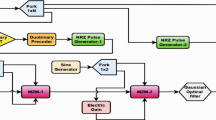Abstract
In this paper, a subspace based blind channel estimation scheme for downlink W-CDMA systems using chaotic codes under Weibull and Lognormal fading channel conditions is proposed and compared with W-CDMA system using PN codes. The algorithm provides estimates of multiuser channels by exploiting the structural information of the data output. The subspace of the (data + noise) matrix contains sufficient information for unique determination of channels and, hence, the signature waveforms and signal constellations. The proposed channel estimation algorithm is also implemented for multiuser—orthogonal frequency division multiplexing (OFDM) system. Performance measures like bit error rate (BER) and root mean square error (RMSE) are plotted for Weibull and Lognormal fading channels. Signal constellations under Weibull and Lognormal channels are also plotted. Analytical and Simulation results for BER and RMSE are compared for W-CDMA system using PN codes and chaotic codes. Simulation results show that, chaos-based W-CDMA outperforms the PN-based W-CDMA in terms BER and RMSE. Simulation results of multiuser-OFDM system shows that performance is further improved when compared to the W-CDMA system.













Similar content being viewed by others
References
Honig, M. L., Madhow, U., & Verdu, S. (1995). Blind adaptive multiuser detection. IEEE Transactions on Information Theory, 41(4), 944–960.
Bensley, S. E., & Aazhang, B. (1996). Subspace-based channel estimation for code division multiple access communication systems. IEEE Transactions on Communications, 44(8), 1009–1020.
Wang, X., & Poor, H. V. (1998). Blind multiuser detection: A subspace approach. IEEE Transactions on Information Theory, 44(2), 677–690.
Gaffar, M. Y. A., Broadhurst, A. D., & Takawira, F. (2005). Improved subspace-based channel estimation algorithm for DS-CDMA systems exploiting pulse-shaping information. IEEE Transactions on Communications, 152(5), 533–540.
Libin, T., Fangjiong, C., & Gang, V. (2004). Blind adaptive multiuser detection based on a constrained MMSE criterion. Journal of Electronics (China), 21(4), 328–331.
Khodr Saiffan, A., Emad, K., & Hussaini, A. L. (2007). Diversity reception of an asynchronous blind adaptive multiuser detector through correlated Nakagami fading channel. Wireless Personal Communications, 40(4), 539–555.
Liu, D., & Hossein, Z. (2007). A multipath interference cancellation technique for W-CDMA downlink receivers. International Journal of Communication systems, 20(6), 661–668.
Torlak, M., & Xu, G. (1997). Blind multiuser channel estimation in asynchronous CDMA systems. IEEE Transactions on Signal Processing, 45(1), 137–147.
Yingguang, Z., Linrang, Z., & Guisheng, L. (2003). Channel estimation of multi-rate DS-CDMA signals in slow fading multipath channels. Journal of Electronics (China), 20(5), 321–325.
Sirbu, M., & Koivunen, V. (2004). Delay estimation in long code asynchronous DS-CDMA systems using multiple antennas. EURASIP Journal on Wireless Communications and Networking, 2004(1), 84–97.
Brand, M. (2005). Fast low-rank modifications of the thin singular value decomposition. MERL, 201 Broadway, Cambridge, MA 02139, USA.
Lau, Y. S., Jusak, J., & Hussain, M. Z. (2005). Blind adaptive multiuser detection for chaos CDMA communications. In IEEE conference on communications (TENCON-2005) (pp. 1–5), Melbourne, Australia.
Xu, M., Song, Y., & Liu, L. (2006). Adaptive blind equalization for chaotic communication systems using particle filtering. In 8th International conference on signal processing (Vol. 3, pp. 16–20), Beijing, China.
Safi, S., Frikel, M., Targui, B., Cherrier, E., Pouliquen, M., & Saad, M. (2010). Identification and equalization of MC-CDMA system driven by stochastic chaotic code. In 18th Mediterranean conference on control & automation congress, Morocco (pp. 1643–1649).
Raju, B. V. S. S. N., & Deergha Rao, K. (2012). Robust multiuser detection in chaotic communication systems over non-gaussian fading channels. IETE Journal of Research, 58(4), 259–265.
Sarperi, L., Zhu, X., & Nandi, A. K. (2006). Low-complexity ICA based blind multiple-input multiple-output OFDM receivers. Digital Signal Processing, 69(13–15), 1529–1539.
Chen, X., & Leyman, A. R. (2007). Blind channel estimation for linearly precoded MIMO-OFDM system. International Journal on Wireless and Optical Communications, 4(3), 207–220.
Khoa, N. L., & Dabke, K. P. (2010). BER of OFDM with diversity and pulse shaping in Rayleigh fading environments. Digital Signal Processing, 20(6), 1687–1696.
Khoa, N. L. (2011). A mathematical approach to edge detection in hyperbolic-distributed and Gaussian-distributed pixel-intensity images using hyperbolic and Gaussian masks. Digital Signal Processing, 21(1), 162–181.
Khoa, N. L., Dabke, K. P., & Egan, G. K. (2006). On mathematical derivations of auto-term functions and signal-to-noise ratios of Choi–Williams, first and nth-order hyperbolic kernels. Digital Signal Processing, 16(1), 84–104.
Khoa, N. L. (2008). Bounds on inter-carrier interference power of OFDM in a Gaussian scattering channel. Wireless Personal Communications, 47(3), 355–362.
Khoa, N. L. (2008). Inter-carrier interference power of OFDM in a uniform scattering channel. Computer Communications, 31(17), 3883–4230.
Sangeetha, M., & Bhaskar, V. (2012). Performance analysis of subspace based downlink channel estimation for W-CDMA systems using chaotic codes. Wireless Personal Communications. doi: 10.1007/s11277-012-0793-1.
Sangeetha, M., & Bhaskar, V. (2012). Performance comparison of various chaotic maps in CDMA-DCSK multiuser SISO systems. International Review on Computers and Software, 7(7), 3402–3408.
Zimeras, S., Lugo, O., & Mchernon, A. G. (1998). A statistical analysis of blind equalization techniques for digital communication. Digital Signal Processing, 66(1), 1–26.
Host-Madsen, A., & Wang, X. (2004). Asymptotic analysis of blind multiuser detection with blind channel estimation. IEEE Transactions on Signal Processing, 52(6), 1722–1738.
Jiang, T., Song, L., & Zhang, Y. (2010) Orthogonal frequency division multiple access fundamentals and applications. Auberbach Publications.
Shyamala, S., & Bhaskar, V. (2011). Capacity of multiuser multiple- input- multiple- output -orthogonal frequency division multiplexing systems with doubly correlated channels for various fading distributions. IET Communications, 5(9), 1230–1236.
Author information
Authors and Affiliations
Corresponding author
Rights and permissions
About this article
Cite this article
Sangeetha, M., Bhaskar, V. & Cyriac, A.R. Performance Analysis of Downlink W-CDMA Systems in Weibull and Lognormal Fading Channels Using Chaotic Codes. Wireless Pers Commun 74, 259–283 (2014). https://doi.org/10.1007/s11277-013-1284-8
Published:
Issue Date:
DOI: https://doi.org/10.1007/s11277-013-1284-8




